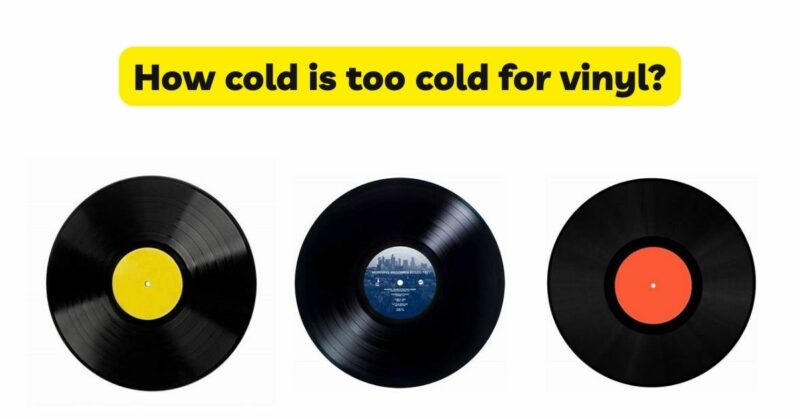Vinyl records have experienced a resurgence in popularity, attracting music enthusiasts with their distinct sound and tangible appeal. As collectors amass larger vinyl collections, the question of optimal storage conditions becomes paramount. While heat and humidity are often discussed, the impact of extremely cold temperatures on vinyl records is equally crucial to understand. In this article, we will explore the effects of cold on vinyl records, discuss the temperature thresholds that can potentially harm them, and provide practical guidance for preserving your vinyl collection.
The Impact of Cold on Vinyl Records:
Vinyl records are made primarily of polyvinyl chloride (PVC), a type of plastic known for its durability and stability. However, extreme cold temperatures can still affect the structure and integrity of vinyl records, leading to potential damage. The following effects may occur due to cold exposure:
- Brittle Material: As vinyl records are exposed to very low temperatures, the PVC material can become brittle and prone to fractures. Brittle records are more susceptible to cracks, chips, and other forms of physical damage, rendering them unplayable.
- Warping: Contrary to popular belief, vinyl records are not immune to warping caused by cold temperatures. When subjected to extreme cold, the vinyl material contracts and becomes more rigid. This contraction can result in warping, causing uneven surfaces that impede playback and distort sound quality.
- Increased Risk of Static Electricity: Cold, dry air can exacerbate static electricity buildup. Vinyl records are already prone to static charges, which can attract dust particles and debris to their surfaces. Increased static discharge during playback can lead to unwanted pops, crackles, and other audible distortions.
- Moisture Condensation: Rapid temperature changes can trigger moisture condensation on vinyl records. When warm records are exposed to cold environments, water droplets can form due to the temperature differential. Condensation poses a risk to the record labels, covers, and even the grooves themselves. Moisture can lead to mold growth, deterioration, and compromised sound quality.
Temperature Thresholds and Risks:
Understanding the temperature thresholds that can potentially harm vinyl records is crucial for preserving their longevity. While vinyl is more resilient than other materials, it is still susceptible to damage under extreme cold conditions. The following temperature ranges should be considered:
- Freezing Point (32°F or 0°C): At the freezing point, vinyl records are generally safe from immediate damage. However, prolonged exposure to freezing temperatures can increase the risk of warping and brittleness. It is advisable to avoid extended exposure to temperatures around or below freezing to maintain the integrity of the records.
- Sub-Freezing (-4°F to 32°F or -20°C to 0°C): In sub-freezing temperatures, vinyl records become more vulnerable to damage. Brittle conditions can arise, increasing the likelihood of fractures, cracks, and other physical damage. Additionally, the risk of warping becomes more significant, affecting the playback quality and rendering the record unusable.
- Extreme Cold (-40°F to -4°F or -40°C to -20°C): Extreme cold temperatures pose substantial risks to vinyl records. The material becomes extremely brittle, heightening the chances of irreparable damage, such as severe cracking or shattering. Warping can occur rapidly and result in unplayable records. It is crucial to protect vinyl records from exposure to extreme cold to avoid these potential hazards.
Protecting Vinyl Records from Cold Damage:
To safeguard your vinyl collection from the adverse effects of cold temperatures, consider the following protective measures:
- Climate-Controlled Storage: Invest in a climate-controlled storage unit or use a vinyl-specific storage cabinet that allows you to regulate temperature and humidity levels. Maintaining a stable environment within the recommended temperature range of 50°F to 70°F (10°C to 21°C) will mitigate the risks of extreme cold damage.
- Gradual Temperature Adjustments: When transitioning vinyl records from a warm space to a cold environment, allow for gradual temperature adjustments. This process helps minimize the potential for condensation and reduces the stress on the vinyl material. Gradual acclimatization helps preserve the records’ integrity.
- Protective Sleeves and Covers: Utilize inner sleeves made of anti-static material to reduce the buildup of static charges. Outer covers should be sturdy and protective, shielding the records from dust, moisture, and temperature fluctuations. Proper sleeves and covers act as an additional layer of defense against cold-related damage.
- Proper Storage Techniques: Store vinyl records vertically to minimize the risk of warping. Avoid placing records directly on cold surfaces, such as concrete floors or metal shelves. Use insulation materials or elevate storage units to create a buffer between the records and the cold environment.
- Regular Maintenance: Implement regular cleaning and inspection routines to identify signs of damage, warping, or mold growth. Use appropriate cleaning methods to remove dust and prevent static buildup. By conducting regular maintenance, you can detect issues early and take corrective measures to preserve the quality of your vinyl collection.
Conclusion:
While vinyl records are known for their durability, extreme cold temperatures can pose risks to their structural integrity. Understanding the effects of cold exposure, temperature thresholds, and protective measures is essential for preserving vinyl records in optimal condition. By maintaining stable storage conditions, employing gradual temperature adjustments, using protective sleeves, and practicing regular maintenance, you can protect your vinyl collection from the damaging effects of extreme cold. Remember, the proper care and attention given to vinyl records ensure their longevity and the continued enjoyment of their unique sound for years to come.


